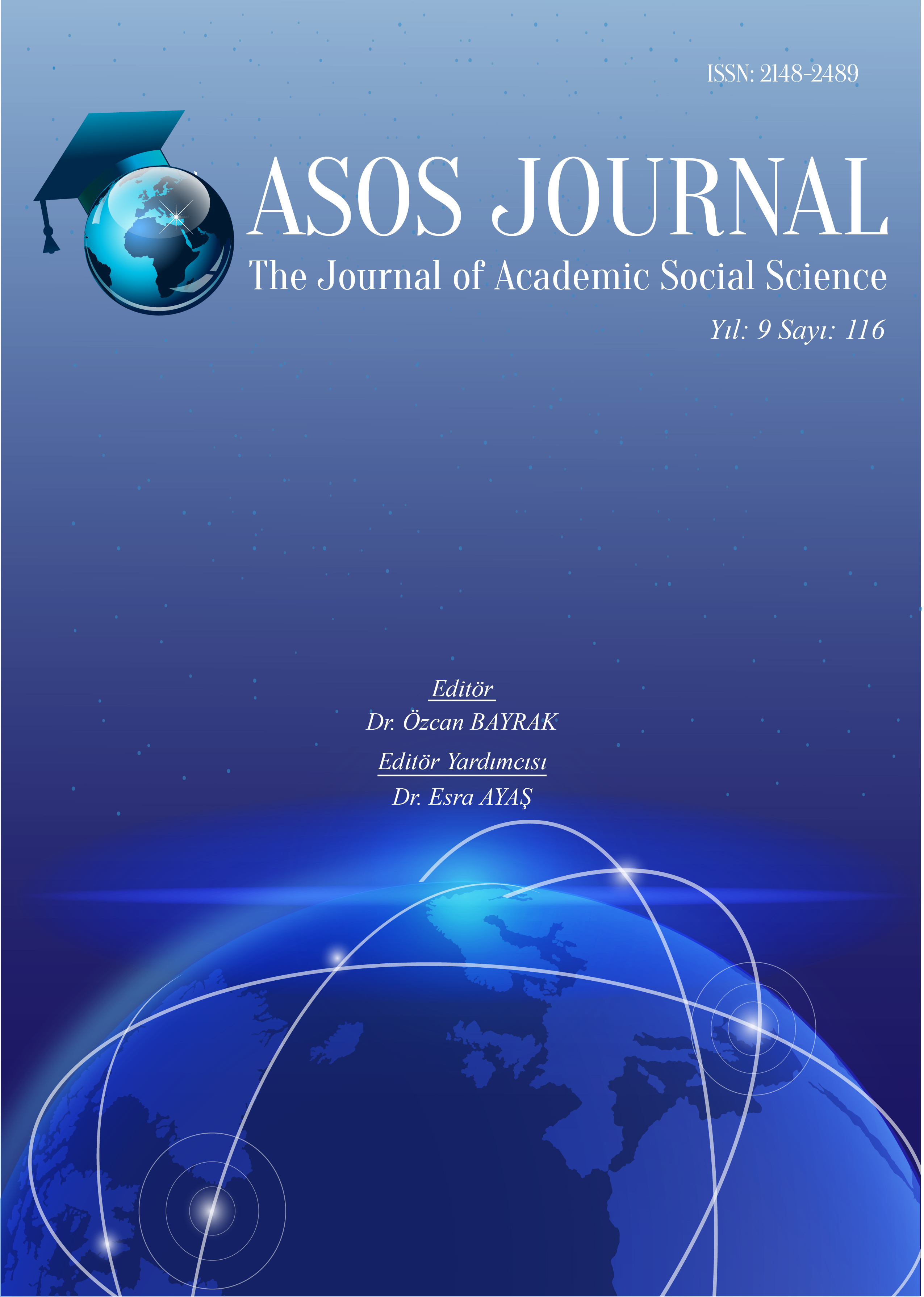AN ANALYSIS OF THE MULTIPLE INTELLIGENCES THEORY IN COURSEBOOKS OF TEACHING TURKISH AS A FOREIGN LANGUAGE
Author :
Abstract
Bu çalışmanın amacı yabancı dil olarak Türkçe öğretimi ders kitaplarında bulunan etkinlikleri çoklu zekâ teorisi ışığında incelemektir. Bu teori, Howard Gardner tarafından 1983 yılında ortaya atıldığından beri eğitimciler tarafından benimsenmiş ve özellikle yabancı dil öğretiminde ilgi görmüştür. Ders kitabı, dil öğretme ve öğrenmede hala en temel materyal olarak yerini korumaktadır; fakat bir ders kitabı tüm öğrencilerin ihtiyacını karşılamakta yetersiz kalmaktadır. Bu nedenle, farklı zekâ türlerine sahip olan öğrencilere hitap edebilmek için ders kitaplarındaki etkinliklerin bu doğrultuda uyarlanması gerekmektedir. Bu çalışmada nitel araştırma deseni kullanılmıştır. Betimleyici yöntem kullanılarak içerik analizi yapılmıştır. Türkiye’de bulunan devlet kurumları tarafından hazırlanmış olan dört farklı ders kitabı incelenmiş ve baskın oldukları zekâ türleri açısından değerlendirilmiştir. Araştırmanın sonucunda dört ders kitabında da sözel-dilsel ve mantıksal-matematiksel zekâ türlerine yönelik etkinliklerin baskın olduğu ortaya konulmuştur
Keywords
Abstract
The purpose of this study is to investigate the activities and tasks in teaching Turkish as a foreign language coursebooks in the light of the multiple intelligences theory. The theory has attracted considerable attention among language teachers and has been implemented in education since it was proposed by Gardner in 1983. The coursebook still remains the primary material used to teach and learn a language; however, it cannot address the needs of all students. Therefore, the high dependency on coursebooks entails the adaptation of activities and tasks to involve all learners who possess a different blend of intelligences. A qualitative research design was adopted to analyse the content through a descriptive method. Four coursebooks prepared by state institutions in Turkey were examined and the dominant intelligence type was determined for each activity and task. The findings of this study suggest that the coursebooks include activities and tasks dominant in the linguistic and logical-mathematical intelligences.
Keywords
- Allen, H. W. (2008). Textbook materials and foreign language teaching: Perspectives from the classroom, NECTFL Review 62, https://www.nectfl.org/wpcontent/uploads/2016/06/review62.pdf#page=11
- Arabski, J. & Wojtaszek, A. (Eds.). (2011). Individual learner differences in SLA. Multilingual Matters.
- Armstrong, T. (2018). Multiple Intelligences in the Classroom: Vol. Fourth edition, ASCD.
- Ary, D., Jacobs, L. C., Irvine, C. K. S. & Walker, D. (2018). Introduction to research in education. Cengage Learning.
- Aydın, H. (2019). The Effect of Multiple Intelligence(s) on Academic Success: A Systematic Review and Meta-Analysis. EURASIA Journal of Mathematics, Science and Technology Education, 15(12).
- Batdı, V. (2017). The effect of multiple intelligences on academic achievement: A meta-analytic and thematic study. Educational Sciences: Theory & Practice, 17(6).
- Boylu, E. & Başar, U. (2018). Yabancı Dil Olarak Türkçe Öğretiminin Kültürel Boyutu: Türkçe Kalip Sözlerin Farslara Öğretimi. Türklük Bilimi Araştırmaları, (43), 31-52.
- Campbell, L. & Campbell, B. (1999). Multiple intelligences and student achievement: Success stories from six schools. ASCD.
- Cunningsworth, A. (1995). Choosing your coursebook. Oxford, England: Heinemann.
- Curdt-Christiansen, X. L. & Weninger, C. (Eds.). (2015). Language, ideology and education: The politics of textbooks in language education. Routledge.
- Çetin, Y. (2012). Ders Kitabi Kültürü: Türk Öğrencilerin Düşünceleri. Elektronik Sosyal Bilimler Dergisi, 11(39), 59-74.
- Eberhard, D.M., Gary F. Simons & Charles D.F. (Eds.) (2020). Ethnologue: Languages of the World. Twenty-third edition. Dallas, Texas: SIL International.
- Gardner, H. E. (1983). Frames of mind: The theory of multiple intelligences. New York: Basic Books
- Gardner, H. (1999). Intelligence reframed: Multiple intelligences for the 21st century. Basic Books.
- Gardner, H. (2006). The development and education of the mind: The selected works of Howard Gardner. Routledge.
- Gardner, H. E. (2011). Frames of mind: The theory of multiple intelligences. Hachette Uk.
- Haley, M. H. (2004). Learner-Centered Instruction and the Theory of Multiple Intelligences with Second Language Learners. Teachers College Record, 106(1), 163-180.
- Hamurlu, K. M. (2007). Çoklu Zeka Kuramına Göre Geliştirilen Eğitim Durumlarının Yabancı Dil Ağırlıklı Lise 9. Sınıf Öğrencilerinin İngilizce Dersindeki Başarılarına ve Derse İlişkin Tutumlarına Etkisi. Yüksek Lisans Tezi, Gaziantep Üniversitesi Sosyal Bilimler Enstitüsü.
- Hsieh, H. F. & Shannon, S. E. (2005). Three approaches to qualitative content analysis. Qualitative health research, 15(9),1277-1288
- Hutchinson, T. & Torres, E. (1994). The textbook as agent of change. ELT Journal. Volume 48, Issue 4, October 1994, Pages 315–328,
- Islam, C. & Mares, C. (2014). Adapting Classroom Materials, In B. Tomlinson (Ed.), Developing Materials for Language Teaching (pp. 86–100). London: Bloomsbury Academic. Retrieved February 15, 2021, from http://dx.doi.org/10.5040/9781474211826.ch-005
- Malabou, C. (2019). Morphing Intelligence: From IQ Measurement to Artificial Brains. Columbia University Press.
- Miles, M. B., Huberman, A. M. & Saldaña, J. (2014). Qualitative data analysis: A methods sourcebook.
- Mutlu, H. & Bağcı Ayrancı, B. (2017). Yabancı Dil Olarak Türkçe Öğretiminde Geçmişten Günümüze Süregelen Problemler, The Journal of International Lingual Social and Educational Sciences, 3 (2), 66-74.
- Nunan, D. (1991). Language teaching methodology. Textbook for Teachers Prentice Hall.
- Petrovic, I. (2013). Analyzing EFL coursebooks in the light of Gardner’s theory of multiple intelligences. Masters Thesis. The University of Nis Faculty of Philosophy.
- Tomlinson, B. (Ed.), (2008). English language learning materials: A critical review.
- Tomlinson, B. (2015). Challenging teachers to use their coursebook creatively in Creativity in the English language classroom, 24-28.
- Uzun, N. E. (2012). Yabancılara Türkçe Öğretiminde Yeni Gelişmeler Üzerine. A. Kılınç & A. Şahin (Ed.). Yabancı Dil Olarak Türkçe Öğretimi. Ankara. Pegem Akademi, s.341-345.
- Yurt, E. & Polat, S. (2015). The effectiveness of multiple intelligence applications on academic achievement: A meta-analysis. Journal of Social Studies Education Research, 6(1).
